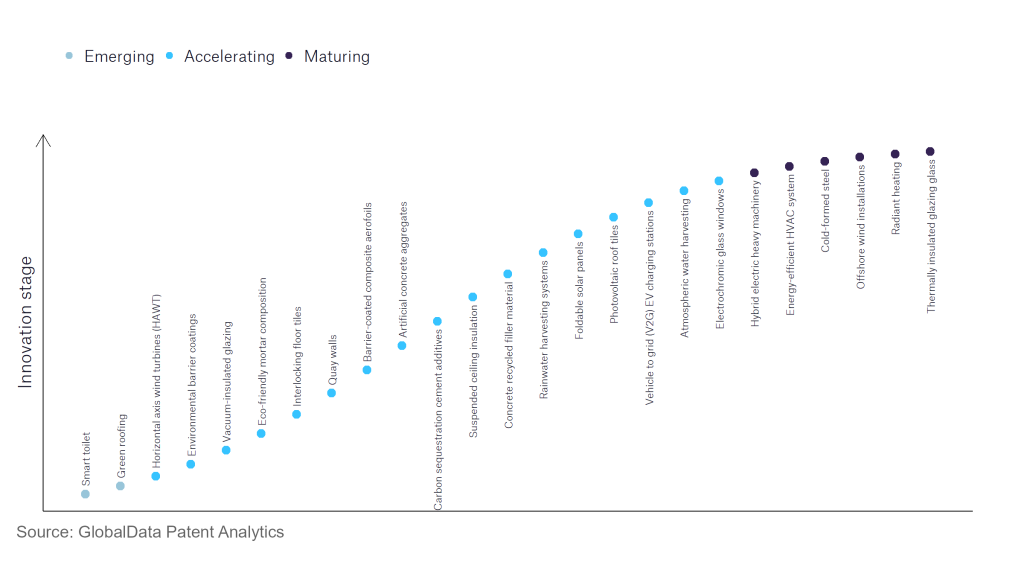The construction industry continues to be a hotbed of innovation, with activity driven by an increased focus on environmental sustainability and workplace safety, and the growing importance of technologies such as the Internet of Things (IoT) and robotics. In the last three years alone, there have been over 248,000 patents filed and granted in the construction industry, according to GlobalData’s report on Environmental sustainability in Construction: Carbon sequestration cement additives. Buy the report here.
However, not all innovations are equal and nor do they follow a constant upward trend. Instead, their evolution takes the form of an S-shaped curve that reflects their typical lifecycle from early emergence to accelerating adoption, before finally stabilising and reaching maturity.
Identifying where a particular innovation is on this journey, especially those that are in the emerging and accelerating stages, is essential for understanding their current level of adoption and the likely future trajectory and impact they will have.
80+ innovations will shape the construction industry
According to GlobalData’s Technology Foresights, which plots the S-curve for the construction industry using innovation intensity models built on over 179,000 patents, there are 80+ innovation areas that will shape the future of the industry.
Within the emerging innovation stage, smart toilets and green roofing are the disruptive technologies that are in the early stages of application and should be tracked closely. HAWT wind turbines, environmental barrier coatings, and vacuum-insulated glazing are some of the accelerating innovation areas, where adoption has been steadily increasing. Among maturing innovation areas are hybrid electric heavy machinery and energy-efficient HVAC system, which are now well established in the industry.
Innovation S-curve for environmental sustainability in the construction industry

Carbon sequestration cement additives is a key innovation area in environmental sustainability
The environmental impacts of the construction sector are wide-reaching, particularly in terms of impact on climate change. The construction and real estate industries are responsible for approximately 29% of all greenhouse gas emissions produced within the European Union (EU). Reflecting this, research has expanded into finding ways to make concrete more environmentally friendly, particularly in terms of incorporating carbon sequestration cement additives. Such technology converts CO2 into a mineral that is then trapped in concrete without compromising on the material’s performance.
GlobalData’s analysis also uncovers the companies at the forefront of each innovation area and assesses the potential reach and impact of their patenting activity across different applications and geographies. According to GlobalData, there are 30+ companies, spanning technology vendors, established construction companies, and up-and-coming start-ups engaged in the development and application of Carbon sequestration cement additives.
Key players in carbon sequestration cement additives – a disruptive innovation in the construction industry
‘Application diversity’ measures the number of different applications identified for each relevant patent and broadly splits companies into either ‘niche’ or ‘diversified’ innovators.
‘Geographic reach’ refers to the number of different countries each relevant patent is registered in and reflects the breadth of geographic application intended, ranging from ‘global’ to ‘local’.
Patent volumes related to carbon sequestration cement additives
Source: GlobalData Patent Analytics
BASF is one of the leading filers in carbon sequestration cement additives, along with Knauff and Schlumberger. In 2021, Schlumberger teamed up with LafargeHolcim to explore the development of carbon capture and storage (CCS) solutions using Schlumberger’s carbon sequestration technologies. Another notable filer is CarbonCure Technologies, which owns the technology to reduce embodied carbon, enabling concrete producers to inject captured CO₂ into fresh concrete during mixing.
In terms of application diversity, James Hardie Industries is among the leaders in the pack, along with Calera, which produces a cementitious material that reduces CO₂ emissions. By means of geographic reach, Cementir is among the leaders along with Denka, which in late 2021 joined with Kajima and Takenaka to research techniques to create carbon-negative concrete.
To further understand the key themes and technologies disrupting the construction industry, access GlobalData’s latest thematic research reports on Construction.
Data Insights
From

The gold standard of business intelligence.
Blending expert knowledge with cutting-edge technology, GlobalData’s unrivalled proprietary data will enable you to decode what’s happening in your market. You can make better informed decisions and gain a future-proof advantage over your competitors.



